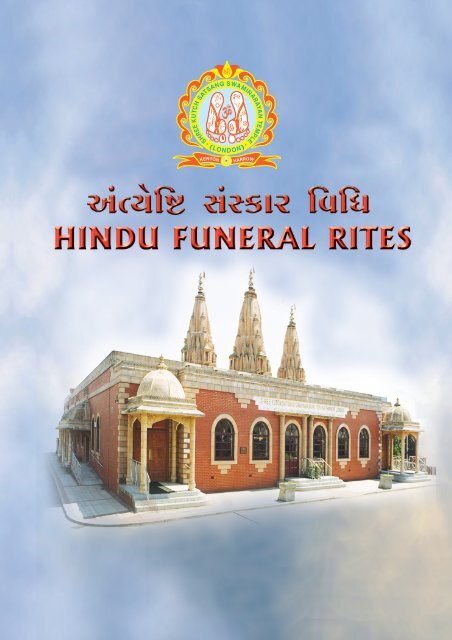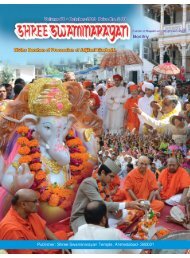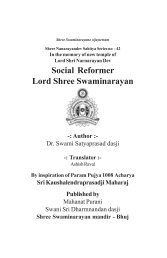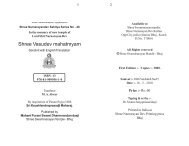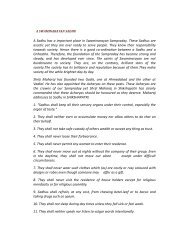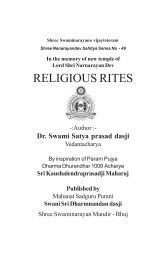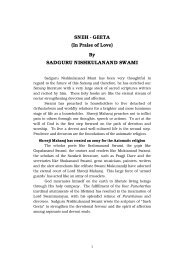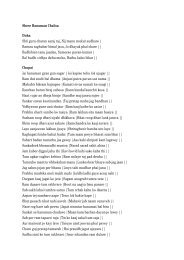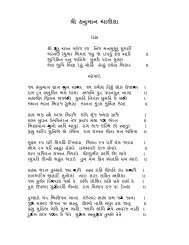ñ - Shree Swaminarayan Temple Bhuj
ñ - Shree Swaminarayan Temple Bhuj
ñ - Shree Swaminarayan Temple Bhuj
You also want an ePaper? Increase the reach of your titles
YUMPU automatically turns print PDFs into web optimized ePapers that Google loves.
4. NARASIMHA 5. VAMANA 6. PARASHURAM<br />
3. VARAHA<br />
2. KURMA<br />
1. MATSYA<br />
AVATARS<br />
“Whenever there is a decay of dharma and a rise in adharma, I embody myself in every yuga.”<br />
“For the protection of the good and the destruction of the wicked, and establishment of religion<br />
and righteousness on a firm footing I am born age after age.”<br />
Bhagavad Gita - Chapter IV Verse 7&8<br />
*An avatar is the descent of God into the material world to uphold righteousness (dharma)<br />
and to preserve and protect the Universe.<br />
SWAMINARAYAN<br />
10.KALKI<br />
7. RAMA<br />
8. KRISHNA<br />
9. BUDDHA
–<br />
–<br />
·· >e ÍC`qMN`r`yn``a qCJytatr`M# ··<br />
·· <strong>Shree</strong> <strong>Swaminarayan</strong> Vijaytetram ··<br />
Az†yaqø SzÍK`r qCqD<br />
HINDU FUNERAL RITES<br />
Brahma<br />
Generator<br />
·· – NM: qÅ`C`y ··<br />
·· Om Namah Shivay ··<br />
Vishnu<br />
Operator<br />
1<br />
Mahesh<br />
Destroyer<br />
–<br />
–
–<br />
–<br />
Hindu Funeral Rites and Rituals<br />
First Edition - 2006<br />
Published by,<br />
<strong>Shree</strong> Kutch Satsang <strong>Swaminarayan</strong> <strong>Temple</strong> (Mandir) London<br />
with the blessings of<br />
Mahant Swami Purani Hariswarupdasji,<br />
<strong>Shree</strong> Swaminarayn <strong>Temple</strong> <strong>Bhuj</strong> – Kutch.<br />
<strong>Shree</strong> Kutch Satsang <strong>Swaminarayan</strong> <strong>Temple</strong> (Mandir) London<br />
Westfield Lane, Kenton, Harrow, Middlesex HA3 9EA.<br />
Tel: 020 8909 9899 • Fax: 020 8909 9897<br />
Ghanshyam Education Centre:Tel/Fax: 020 8909 9389<br />
Website: www.sksst.org • Email: info@sksst.org<br />
Printed by: Prontaprint Wembley<br />
147 Wembley Park Drive,Wembley, Middx. HA9 8HQ.<br />
Tel: 020 8903 3280 • Fax: 020 8903 6634<br />
Website: www.prontaprint.com<br />
Email: sales@wembley.prontaprint.com<br />
2<br />
–<br />
–
–<br />
–<br />
<strong>ñ</strong> ANw…Mqn`K` - Contents <strong>ñ</strong><br />
Page<br />
<strong>Temple</strong> Activities ..................................................................................................4<br />
Foreword ...............................................................................................................5<br />
Reporting Of Death ............................................................................................6<br />
˘l`aK-Ít`aI...............................................................................................................8<br />
fÍt`qCK` .................................................................................................................9<br />
Preface .................................................................................................................12<br />
Az†yaqø SzÍK`r qCqDN`a S`qh†y - Items Required For The Ceremony .....17<br />
Az†yaqø SzÍK`r qCqD - Gra ..................................................................................18<br />
Az†yaqø SzÍK`r qCqD - ÍMÅ``Na ..........................................................................21<br />
ÍMÅ``N ÍY`Na SzB`aDN .........................................................................................22<br />
Rites Performed At Home................................................................................23<br />
Rites Performed At Crematorium And Address To The Audience ........27<br />
AqgN SzÍK`r fxeNe qCqD ...................................................................................28<br />
Ceremony Performed After The Funeral......................................................29<br />
SzqXƒt SWtK qNn`¡y ..............................................................................................30<br />
Sutak ......................................................................................................................33<br />
>e hNwM`N c`qlS` ...............................................................................................36<br />
<strong>Shree</strong> Hanuman Chalisa ...................................................................................38<br />
>e JNMzg`l Ít`aI - <strong>Shree</strong> Janmangal Satotra ..............................................40<br />
A`J Ske A`NzdNe hale - Aaj Sakhi Anandni Heli.......................................43<br />
tMa
–<br />
–<br />
<strong>ñ</strong> <strong>Temple</strong> Activities <strong>ñ</strong><br />
Rememberance Services (Prathna Sabha)<br />
Rememberance Services are held every Saturday afternoon<br />
for people who have departed from this earth.<br />
The temple provides Malas and scriptures for home sabha.<br />
<strong>ñ</strong> <strong>ñ</strong> <strong>ñ</strong> <strong>ñ</strong> <strong>ñ</strong><br />
Library<br />
<strong>ñ</strong> <strong>ñ</strong> <strong>ñ</strong> <strong>ñ</strong> <strong>ñ</strong><br />
Bal Yuvak Mandal (Boys & Girls)<br />
<strong>ñ</strong> <strong>ñ</strong> <strong>ñ</strong> <strong>ñ</strong> <strong>ñ</strong><br />
Gujarati Classes (GCSE)<br />
<strong>ñ</strong> <strong>ñ</strong> <strong>ñ</strong> <strong>ñ</strong> <strong>ñ</strong><br />
Hinduism Classes (GCSE)<br />
<strong>ñ</strong> <strong>ñ</strong> <strong>ñ</strong> <strong>ñ</strong> <strong>ñ</strong><br />
Ghanshyam Nursery School<br />
<strong>ñ</strong> <strong>ñ</strong> <strong>ñ</strong> <strong>ñ</strong> <strong>ñ</strong><br />
Adult Computer Classes<br />
<strong>ñ</strong> <strong>ñ</strong> <strong>ñ</strong> <strong>ñ</strong> <strong>ñ</strong><br />
Adult English Classes<br />
<strong>ñ</strong> <strong>ñ</strong> <strong>ñ</strong> <strong>ñ</strong> <strong>ñ</strong><br />
Revision Classes (GCSE)<br />
<strong>ñ</strong> <strong>ñ</strong> <strong>ñ</strong> <strong>ñ</strong> <strong>ñ</strong><br />
Tabla and Harmonium Classes<br />
<strong>ñ</strong> <strong>ñ</strong> <strong>ñ</strong> <strong>ñ</strong> <strong>ñ</strong><br />
Celebrations of all Hindu Festivals<br />
4<br />
–<br />
–
–<br />
–<br />
<strong>ñ</strong> Foreword <strong>ñ</strong><br />
The committee of <strong>Shree</strong> Kutch Satsang <strong>Swaminarayan</strong> <strong>Temple</strong>,<br />
London, Kenton, Harrow, felt it necessary to compile a small booklet<br />
to guide families on this country’s laws and requirements to register<br />
death as well as the ceremonies and rituals that a Hindu family may<br />
deem necessary to carry out in order for the completion of the<br />
sixteenth and final sanskar.<br />
It is not intended for the funeral rites explained in this booklet to be<br />
carried out methodically as each and every family is unique in the way<br />
that they interpret and adapt to circumstances within themselves. All<br />
that this booklet aims to do is ensure that loved ones are given a final<br />
farewell with love and dignity.<br />
This booklet contains many of the final rites which are deemed<br />
customary to be performed at home as well as those to be<br />
completed at the crematorium. It should be stressed that it is not<br />
necessary for a Brahmin to be present at this final ceremony, as in the<br />
Hindu religion this ritual can be presided over by anyone with the<br />
help of this booklet.<br />
The information necessary for this booklet was gathered from<br />
various scriptures of the <strong>Swaminarayan</strong> Sampraday. If this booklet<br />
contains any errors or omissions, they are sincerely regretted.<br />
We offer gratitude to those devotees who have provided, funding<br />
information, guidance and suggestions, for the publication of this<br />
booklet.<br />
5<br />
–<br />
–
–<br />
–<br />
SUDDENLY<br />
IN HOSPITAL AT HOME<br />
HOSPITAL INFORMS INFORM DOCTOR AND POLICE<br />
NEXT OF KIN<br />
POLICE AND DOCTOR<br />
RELATIVE GOES TO<br />
HOSPITAL FOR<br />
IDENTIFICATION<br />
OF BODY<br />
NOTES :-<br />
SELECT FUNERAL DIRECTOR AS SOON AS<br />
POSSIBLE TO AVOID DELAY<br />
RELEVANT FORMS :-<br />
MEDICAL CERTIFICATE<br />
Issued by Doctor if Death is not referred to<br />
a coroner. Formal notice issued by Doctor.<br />
REPORTING OF DEATH<br />
NOTIFICATION BY THE CORONER:-(Pink Form)<br />
Issued by Coroner, if Death is referred to a Coroner.<br />
CERTIFICATE FOR CREMATION:- (Cream Form)<br />
Issued by Coroner if there is a post mortem or an<br />
inquest.<br />
CERTIFICATE OF REGISTRATION OF DEATH :-<br />
For Social Security purpose only.<br />
DEATH CERTIFICATE:-<br />
Issued by Registrar, Certified copy of the<br />
entry in the Death Register.<br />
IF CORONER TAKES<br />
NO FURTHER ACTION<br />
OBTAIN FROM DOCTOR<br />
MEDICAL CERTIFICATE OF<br />
CAUSE OF DEATH AND<br />
FORMAL NOTICE<br />
FOR CREMATION<br />
ASK DOCTOR TO<br />
COMPLETE FORMS B & C<br />
6<br />
CORONER<br />
INFORMED ALSO<br />
INFORM HIM THAT<br />
CREMATION IS<br />
REQUIRED<br />
ORDERS<br />
POST-MORTEM<br />
HOLDS INQUEST<br />
CORONER ISSUES<br />
“NOTIFICATION BY THE CORONER”<br />
(PINK FORM - 100) AND<br />
CERTIFICATE FOR CREMATION<br />
FORM - E - (CREAM)<br />
CONTACT REGISTRAR<br />
REGISTERS DEATH AND<br />
OBTAIN DEATH CERTIFICATE<br />
CONTACT FUNERAL<br />
DIRECTOR FOR REMOVAL<br />
OF BODY AND FINAL<br />
ARRANGEMENTS<br />
–<br />
–
–<br />
–<br />
IF DOCTOR CANNOT<br />
ISSUE MEDICAL<br />
CERTIFICATE OF<br />
CAUSE OF DEATH<br />
CORONER INFORMED<br />
ALSO INFORM HIM<br />
THAT CREMATION IS<br />
REQUIRED<br />
ORDERS<br />
POST-MORTEM<br />
HOLDS INQUEST<br />
CORONER ISSUES<br />
“NOTIFICATION BY<br />
THE CORONER”<br />
(PINK FORM - 100)<br />
AND CERTIFICATE<br />
FOR CREMATION<br />
FORM - E - (CREAM)<br />
CONTACT DOCTOR<br />
REPORTING OF DEATH<br />
EXPECTEDLY<br />
AT HOME IN HOSPITAL<br />
OBTAIN FROM DOCTOR<br />
MEDICALCERTIFICATE OF<br />
CAUSE OF DEATH<br />
AND FORMAL NOTICE<br />
FOR CREMATION<br />
ASK DOCTOR TO<br />
COMPLETE FORMS B & C<br />
CONTACT REGISTRAR<br />
REGISTERS DEATH.<br />
ISSUES<br />
DEATH CERTIFICATE<br />
CONTACT FUNERAL<br />
DIRECTOR FOR REMOVAL<br />
OF BODY AND FINAL<br />
ARRANGEMENTS<br />
7<br />
HOSPITAL INFORMS<br />
NEXT OF KIN AND DOCTOR<br />
RELATIVE GOES TO<br />
HOSPITAL FOR<br />
IDENTIFICATION OF BODY<br />
DECIDE ON CREMATION<br />
OBTAIN FROM DOCTOR<br />
MEDICAL CERTIFICATE OF<br />
CAUSE OF DEATH<br />
AND FORMAL NOTICE<br />
FOR CREMATION<br />
ASK DOCTOR TO<br />
COMPLETE FORMS B & C<br />
–<br />
–
–<br />
–<br />
<strong>ñ</strong> ˘l`aK - Ít`aI <strong>ñ</strong><br />
- KY` f`rz< SMya B`al`t` ˘l`aK -<br />
>eC`SwdaCqCMl` M@tD`MC`Sz, N`r`yn`z NrKt`rn`N`MDayM# ·<br />
Åy`Mz qStz q»
–<br />
–<br />
<strong>ñ</strong> fÍt`qCK` <strong>ñ</strong><br />
AzNtK`aoe Bm`z[N` AqDfqt AaC` >e fWn`¡ fw®s`aTMN`r`yn`<br />
(>e ÍC`qMN`r`yn`) A` S@qøN` rcyet` xa. SjC ANa Nej¡C SC¡Ne<br />
u†fte KrN`r
–<br />
–<br />
dahM`z rhe jC`†M` frM`†M`Ne f`ƒte Kre Å`Ka xa. fn` frM`†M`Na f`ƒt<br />
KrC` M`oa jCNa MNwßy JˆM D`rn` Ky`¡ fxe S`aL SzÍK`r`a KrC` JRre xa.<br />
Ôy`ra MNwßy M@†yw f`Ma †y`ra ta jC`†M`Ne Å``zqt M`oa tY` A`<br />
JˆMNa qCsa Ja f`f Ky`¡ h`ay taNe Å``zqzt M`oa M`NCN` jCNN`a xa¬l`a SzÍK`r<br />
Az†yzøe SzÍK`r KrC`M`z A`Ca xa. A`M t`a MNwßyNwz M@†yw Y`y, fxe taN`a<br />
jC`†M` NC qdCS SwDe t`a f`at`N` GrNe A`Sf`S FreNa AqgNd`h Ckta<br />
Ja Mr[ey` (fÁYr) ufr Kwz
–<br />
–<br />
·· NåNz xadˆte Å`ÍI`n`e NåNz dhqt f`CK ··<br />
ta Å`ÍIYe xad`t`a NYe, ta BLt`a NYe. jC t`a AJr, AMr xa. A`<br />
jC f`at`N` KM`a¡Na ANwS`ra C`rzC`r ANaK y`aNeM`z JˆMNa f`ƒt Kra xa.<br />
Å``ÍIM`z KhaC`M`z A`Ca xa Ka 84 l`k ˙tNe Jwde Jwde y`aNeA`a xa. taM`z<br />
KM`a¡ MwJB jC JˆMNa D`rn` Kra xa. fn` Ôy`ra MNwßy ACt`r f`ƒt Yy`a<br />
xa †y`ra jC`†M` frM`†M`Ne Szfwn`¡ Å`rn``g`qt ÍCeK`re la t`a ta JˆM<br />
Mrn`N` BzDNM`zYe MwÚt YE frM`†M`N` D`MM`z frM`†M`Ne crn` KMLNe<br />
SaC`M`z K`yM M`oa C`S KreNa rha xa.<br />
frM`†M`Aa A`fn`Na Ja Å`rer A`ƒywz xa ta BhwJ qCfret xa. ta f`zc<br />
–<br />
–<br />
<strong>ñ</strong> PREFACE <strong>ñ</strong><br />
Lord Purushottam Narayan the Supreme Lord of the entire<br />
Kingdom of God is the sole creator of the whole Universe. He is the<br />
creator and destroyer of everything on this Earth, living and nonliving.<br />
Consequently, He is the Mother as well as the Father to all lives<br />
and that is why we pray to Him everyday.<br />
“You are the Mother, You are the Father,<br />
You are the Brother, You are the Friend,<br />
You are the Knowledge and you are my sole Deity.”<br />
When the whole world was destroyed it was drowned in the<br />
sea, in that state Lord Purushottam Narayan also retired on the sea<br />
bed known as Sukh Saiyasa of Sheshnagji.<br />
When the time came to create a new world, a Lotus<br />
emerged from His naval and came to the surface. Purushottam<br />
Narayan created Brahma from the Lotus. Lord Brahma then heard<br />
the invincible voice of the Lord “Create, Create.” Hearing the voice,<br />
Lord Brahma searched everywhere in the very long hollow stem of<br />
the Lotus for several years to find the source of the voice but he was<br />
not successful.<br />
In the end he realized that Lord Purushottam Narayan was<br />
instructing him to create the Universe. First he created the couple<br />
named Manu and Satrupa.Then he created the Devas and all beings<br />
on this earth.<br />
Every life, which takes birth on this Earth, is sure to die. No<br />
one can ever make any change to this certainty. One cannot delay or<br />
avoid it. Hindu scriptures state that our Souls travel a journey<br />
through a series of births and deaths until we reach salvation. So we<br />
should not be afraid of death, but instead we should try to improve<br />
our death by worshipping Lord <strong>Swaminarayan</strong> and follow the Holy<br />
Shikshapatri and maintain attachment to Him through religious<br />
12<br />
–<br />
–
–<br />
–<br />
media. This will reform our death and enable us to swim the<br />
ocean-like worldly life.<br />
The Soul is selfish so it forgets the Lord once it is born on<br />
this earth. When it is in a Mother’s womb as an embryo, suffering<br />
with several disorders and severe pain, it prays to the Almighty Lord<br />
several times “Please Lord, relieve me from the present situation and<br />
I will never forget you. I will do as you say.” As soon as it is relieved<br />
from the pain of birth and delivered on this Earth and becomes<br />
independent it forgets the Lord and surrenders to the Maya [illusion].<br />
Everything on this Earth is compassionate and uncertain and<br />
there are constant changes like a rotating wheel. Consequently the<br />
Soul follows a cycle of Life and Death through eight million four<br />
hundred thousand different life forms.<br />
During this cycle the Soul performs some good deeds whilst<br />
going through several births and when all these good deeds assemble<br />
together with the mercy of Lord <strong>Swaminarayan</strong>, it gains the human<br />
form. It is only through the physical features of a human that the Soul<br />
can achieve salvation and seek the Abode of the Lord and finally rest<br />
peacefully with the Lord, thus breaking free from the cycle of birth<br />
and rebirth (transmigration).<br />
The Hindu scriptures teach us to perform the sixteen rites<br />
(Sanskar) during a human life. Aantyeshti Sanskar is the final rite<br />
performed for the eternal peace of the Soul.<br />
By observing these solemnities and behaving in accordance with<br />
these Holy Scriptures we can reach the Lord’s heavenly abode, the<br />
Akshardham.<br />
In general, when a person dies, the Soul wanders or roams<br />
around the house and near to the urn where the deceased’s ashes<br />
are stored after the cremation ceremony (Hanged On Limestone).<br />
After cremation, to get peace for the Soul, the relatives pour<br />
water on the Limestone where the urn is hung.This enables the Soul<br />
to proceed further.<br />
13<br />
–<br />
–
–<br />
–<br />
The question arises as to why we carry out Tenth and Twelth<br />
day ceremonies after the Death?<br />
By performing these ceremonies, we are praying to the Lord<br />
to grant proper physical features (Pind) of the Soul so that in the next<br />
life it is born with all the physical features of the body.<br />
A Ghee lamp is lit so that the Soul has eternal-sight in the<br />
after life.<br />
On the twelth day the relatives of the deceased give water<br />
to the Soul by pouring water over the tail of a young cow believing<br />
that it will help the Soul to swim through the River Vaitrani by holding<br />
onto the tail of the cow. Each and every Soul has to pass through the<br />
Vaitrani River. Usually all relatives attend on the particular day to<br />
Give Water to the deceased.<br />
There are four stages to the ceremonies :-<br />
• Prayschit<br />
• Dahan (Cremation)<br />
• Shradh<br />
• Daan<br />
All the ceremonies performed after the death, have some<br />
particular importance. Especially to see that in the next life the<br />
migrating Soul does not face any inconveniences and achieves perfect<br />
peace and happiness.<br />
The relatives of the deceased give donations to Holy<br />
Brahmins and poor people and perform religious acts in his or her<br />
name to erase any bad deeds carried out by the Soul knowingly or<br />
unknowingly during its lifetime. Charitable and religious acts are also<br />
carried out to please Lord <strong>Swaminarayan</strong> and to be in His Heavenly<br />
Abode (Akshardham).<br />
When a person dies, it is the physical aspect, which actually<br />
dies. The Soul within the body never dies. That is why the Bhagvad<br />
Gita says<br />
14<br />
–<br />
–
–<br />
–<br />
“Nainm Chhedanti Shastrani, Nainm Dahati Pavak”<br />
(The soul is never cut by any weapon nor it is burnt with any fire).<br />
The Soul is immortal and impenetrable. The Soul uses the body as a<br />
tool and when the mission is over the Soul abandons the body and<br />
continues its journey in another body.<br />
The physical body, which Lord <strong>Swaminarayan</strong> has given us, is<br />
mortal. It comprises of the five inanimate elements Earth, Light,<br />
Water, Sky and Air. After the death the physical body merges in those<br />
five elements.That is why Lord Krishna has said in Bhagvad Gita.<br />
“Aham Vaishwanaro Bhutva”<br />
(I provide food to all living creatures on this Earth. I eat everything what they eat)<br />
This teaches us that God is the giver of everything but also<br />
that He takes everything back. Through birth God gives us Life and<br />
He takes it back through Death. So, what we own and possess, is<br />
entirely through His giving.When we lose our relative through death,<br />
we feel sorrow and unhappiness.<br />
The Holy Scriptures like Garood Puran say that it is not wise<br />
to cry after our loved ones, as when we cry it makes it difficult for<br />
the Soul to proceed further in its lonely journey. It is better to chant<br />
Lord <strong>Swaminarayan</strong>’s name or read Holy Scriptures instead of<br />
grieving. This will provide strength to the Soul in its onward journey<br />
towards righteousness (Punya) and in addition we shall add some<br />
good deeds in the account of our own Karma.<br />
It is a general custom in the Hindu Community that the ashes<br />
of the deceased are scattered in a Holy River or Sea within ten days<br />
from the demise. The Pind daan ceremony is carried out by a Holy<br />
Brahmin.<br />
After the rites are fulfilled, the Soul proceeds further and<br />
enters the next phase of its destined journey in another world. In<br />
some Hindu Communities it is a custom to feed Brahmins and<br />
relatives with a feast. Brahmins and the young related females are<br />
15<br />
–<br />
–
–<br />
–<br />
given charity along with the feast. It is a belief that by doing so the<br />
soul achieves peace and comfort in the eternal world.<br />
It is Hindu custom to sing hymns and read Holy Scriptures like:-<br />
• Fifteenth Discourse of <strong>Shree</strong>mad Bhagwad Gita<br />
• Purushattom Yog.<br />
• Bhakta Chintamani. (Forest mission of Nilkanth)<br />
• Vachnamrut<br />
Therefore, death is an inevitable and unavoidable event.That<br />
is why the Final Rites are very important and it is the final event of<br />
human life. If these Aanteyshti Sanskars (Final Rites) are carried out<br />
with the proper eligible ceremonies, the Soul is blessed with eternal<br />
peace and gets the opportunity to enjoy the heavenly happiness it<br />
desires.The relatives also receive condolence and they gain strength<br />
from knowing that their loved one is at peace. ü<br />
<strong>ñ</strong> ˘l`aK-Ít`aI <strong>ñ</strong><br />
KÍtwqrqTlzKz ll`o folå C¡XÍYla K`åÍtw
–<br />
–<br />
<strong>ñ</strong> Az†yaøe SzÍK`r qCqDN`a S`qh†y <strong>ñ</strong><br />
<strong>ñ</strong> Items required for the ceremony <strong>ñ</strong><br />
czdN Chandan<br />
KzKw Kanku<br />
tl Tal (Sesame seeds)<br />
JC Jav (Barley)<br />
Swk[N`a h`r Sandalwood garland<br />
4 Swk[N` l`K[` 4 Pieces of Sandalwood<br />
g`zg`` JL/cn``¡M@t Gangajal/Parsadi water<br />
S`aNwz AYC` c`zde (rak[`) Small piece of gold or silver<br />
fqCIe Ce~oe Pavitri ring<br />
(d
–<br />
–<br />
<strong>ñ</strong> Az†yaøe qCqD - AqgN SzÍK`r <strong>ñ</strong><br />
M@tdah Gra A`Çy` fxeNe qCqD<br />
ÇyqÚtNa AqgNd`h Krt`z fhal` Neca MwJBNe qCqDKrC`M`z A`Ca xa.<br />
1. FywNrl [`yraKor S`Ya MLe Sd#g`tN` M@tdahNa ÍN`N Kr`CC`,<br />
CÍI fhar`CC` ANa Gra l`CC` ÇyCÍY` KrCe.<br />
2. ÇyqÚtNwz M@†ywz Y`y Ka trtJ AaK GeN`a deC`a fg`o`CC`a.<br />
3. AzqtMqCqD KrC` M`oa Azg`t Sg``Na B`al`CC`.<br />
4. M@tdahNa Gra l`C`a †y`r fhal`z Ja Jgy`Aa M@tdahNa MwKC`N`a h`ay<br />
†y`z Å`w\ SFad A]e Meor CÍI Ja S†Cg`wn`Ne qNÅ``Ne xa ta f`Yr`a<br />
†y`z x`zn`Ye lefe c`aK`a Kr`a g``åMwI tY` g`zg``JL AYC`
–<br />
–<br />
10. fxe >e hqrNe fS`deNwz JL AYC` g`zg``JLNe D`r<br />
Sd#g`tN`MwkM`z KrCe ANa twlSeNwz f`N fn` MwkM`z MwKCwz ANa<br />
NecaN` MzI`a B`alC`<br />
·· – >e K@ßn``y NM: ·· – C`SwdaC`y NM: ·· – hqrK@ßn``y NM: ··<br />
AYC`<br />
·· – KaÅ`C`y NM: ·· – N`r`yn``y NM: ·· – M`DC`y NM: ··<br />
twlSeNe M`L` M@tdahN` KzpM`z fhar`CCe ANa Kf`LNe ufr<br />
czdNN`a laf KrC`a-czdNNwz l`K[wz ANa twlSeN` K`ø M@t`†M`Ne<br />
B`JwM`z MwKC`.<br />
11. †y`r fxe q…y`qCqD KrN`r ÇyqÚtAa fe~[d`N KrCwz. c`ak`N`<br />
l`aoN` N`N` x Qf[ BN`CeNa M@t`†M`N` Å`rer fr MwKC` Ba K`Na,<br />
Ba A`zk`aAa, AaK N`Ka, AaK Mwka A`M x ÍY`Na MwKC`z<br />
†y`r B`d S`aN` AYC` c`zdeN` rak[`z MwKC`. (Å`qÚt fM`n`a)<br />
12. †y`rB`d Swk[Ne AYC` twlSeNe M`L` JMn`` h`YM`z M@t`†M`Na<br />
A`fCe-Kw¬la c`r N`Leyar laC` ANa Ba k
–<br />
–<br />
(hCaNe q…y` BDe ÍMÅ``N
–<br />
–<br />
– CS`a: fqCIMqS Å`tD`rz, CS`a fqCIMSe ShÍI D`rz ··<br />
daC͆C` SqCt` fwN`tw, CS`a: fqCIan` Å`t D`ran` SwƒtC K`M DwÙC: ··<br />
23. †y`r fxe A]e Meor Ja Kf[wz A`a]`[C` l`Çy` h`aEAa ta Kf[wz<br />
M@tdahN` Å`rer ufr A`a]`[Cwz. †y`r fxe SMy fM`n`a EødaCNe<br />
DWN B`alCe, AzJqlg`et, caø`N` fd`a g``C`.<br />
24. M@tdahNe faoeNa BzD Krt`z fhal`z Neca f`YrC`M`z A`Cal<br />
SFad K`f[ faoeM`z MwKCwz.<br />
25. Å`B faoe uf`[a †y`ra fhale JMn`e K`zD qCqD KrN`rNa daCe, qCqD<br />
KrN`ra M@tdahN` [`B` fg` B`JwN` kWn``Na K`zD A`fCe ANa Be˙<br />
fwI`a AYC` Sg`` SBzDeA`aAa K`zD daCe, f`at`N` EødaCN` N`MNe<br />
DWN AYC` N`M ÍMrn` KrCwz ANa ÍMÅ``Na lE JC`.<br />
26. Å`Bfaoe uf`[a †y`ra fg` A`g`L r`kC` ANa …aMao`areyMNe Bh`r<br />
†y`zYe Å`BfaoeNa FarCe M@t`†M`Nwz MÍtK A`g`L KrCwz ANa qCS`M`a<br />
A`fC`a. †y`rB`d k
–<br />
–<br />
<strong>ñ</strong> ÍMÅ``N h`alM`z SzB`aDN <strong>ñ</strong><br />
C[el`a, ©`qtJN`a ANa qMI`a,<br />
A`Ja A`fn`a Sg`¡ÍY (N`M)............................... (AoK)........N`<br />
AqgN SzÍK`rN` qdCSa e ÍC`qMN`r`yn`<br />
–<br />
–<br />
<strong>ñ</strong> Rites Performed At Home <strong>ñ</strong><br />
Preparation of last rites is emotional and stressful, and generates<br />
feeling of hopelessness, but it is a very important cermony for<br />
Hindus, as properly performed ceremony provides peace to the<br />
departed soul and comfort to the relatives.<br />
The following steps are taken to prepare the home ceremony for<br />
the last rites<br />
1. Liaise with funeral director to carry out bathing and<br />
dressing of the deceased’s body at the place of rest and<br />
to bring the body home at a convenient time for the<br />
family.<br />
2. Dipak of Ghee should be lit as soon as possible in front<br />
of a photograph of the deceased.<br />
3. Family members should be invited during the ceremony.<br />
4. Before the body arrives, place 2.5M. long white cloth<br />
on the floor, apply cow dung and sprinkle Gavmutara,<br />
Ganga Jal (or Parsadi water), sesame seeds and holy grass<br />
so that the place is purified.<br />
5. When the body arrives home make sure that the head<br />
of the deceased is placed facing North.<br />
6. It is essential that the Eldest or youngest son performs<br />
final rites, the Hindu scriptures forbids the middle son<br />
to perform final rites. (If the deceased does not have a son,<br />
then it should be performed by another male member of the<br />
family).<br />
7. One person should conduct this ceremony as below.<br />
8. He wears Pavitri ring on second last fingure of the right hand<br />
and hold water in right hand and say<br />
Atha then say Lunar Month ............... Paksh............. Date .............<br />
Name of the deceased .................................... and Gottra ..................<br />
(If Gottra is not known say Gottshya Kashyapsha)<br />
Pretashya Pretatv Nivrutyth<br />
Nivrutyatha Outam loka Praptyatha<br />
Aham Advrdehik Karm Karishye.<br />
Then release water.<br />
23<br />
–<br />
–
–<br />
–<br />
9. The person performing the ceremony should sprinkle<br />
water on to the body and say following mantra;-<br />
• Ohm apo hishtha myo bhuv stan ourj dthatn II<br />
• Mahernay chaksashe II<br />
• Ohm yova: sjivtamo rash stasya bhajyate hana: II<br />
• Ushtiriva matar: II<br />
• Ohmtasma arang mamvo yasya shayay jinvath II<br />
• Apo jan ytha chan: II<br />
10. Then give Tulsi leaf, Ganga Jal or Parsadi Water in deceased’s<br />
mouth and say the following mantra:-<br />
• Ohm <strong>Shree</strong> Krushanay namah; II<br />
• Ohm Vasudevay namah: II<br />
• Ohm Harikrushanay namah; II<br />
Or say<br />
• Ohm Keshvay namah: II<br />
• Ohm Naraynayana namah: II<br />
• Ohm Madhavay namah: II<br />
Then place mala on the neck, apply chandan paste<br />
onto the forehead and place pieces of Sandalwood/Tulsi<br />
wood near the body.<br />
11. Then the person performing the ceremony should give<br />
pind daan as follows:<br />
• Place six small balls made from rice<br />
Two near ears,Two near eyes one near nose and one<br />
near mouth.<br />
• Place small Silver or Gold piece.<br />
12. Then give either Sandalwood or Tulsi mala in the right<br />
hand and place two coconuts one each at the right and<br />
left shoulder and two at the feet.<br />
13. Then give a Sandalwood garland or fresh flower<br />
garland.<br />
• For male apply either Chandan or Kanku chandlo on<br />
the forehead.<br />
• For females apply Chandan chandlo only.<br />
14. Then apply Ghee or Butter on the following parts of the<br />
body:- On the Head, both Eyes, Heart and both Feet.<br />
24<br />
–<br />
–
–<br />
–<br />
15. Then the wife of the deceased person should remove<br />
bangles from her hands, break them and place them<br />
near his right hand.<br />
16. Then person performing ceremony gives two pind<br />
(rice balls) and say the following :-<br />
• First pind is placed near the right hand for the pleasure of<br />
Dwara Adhithastri Devtani Trupti Arthe.<br />
Second pind is placed near the first pind for the<br />
pleasure of<br />
Bhumi Adhistatri Devtani Shanti Arthe.<br />
• (Light fire in the clay pot)<br />
17. Then all close family members one after other perform<br />
darshan of the deceased giving either flower or barley<br />
and do pradakshina.<br />
(Traditionally the following rituals are performed at the<br />
place of cremation but in U.K. it is not possible so<br />
it is performed at home.)<br />
18. Then the person performing the ceremony should light<br />
one aggarbati holding in the right hand and do three<br />
pradakshina anti clockwise, during the fourth pradakshina<br />
If the deceased is male apply aggarbati (Fire) on his head,<br />
extinguish and place aggarbati in the coffin and complete<br />
the pradakshina.<br />
If the deceased is female complete fourth pradakshina<br />
apply aggarbati (Fire) on her feet, extinguish and place<br />
aggarbati in the coffin.<br />
19. Then sprinkle Tal (Sesame seeds) and Jav (Barley) on the<br />
body reciting the following mantras:<br />
Prajaptaye swaha II Prajaptay indn mam II<br />
Indray swaha II Indray indn mam II<br />
Agnye swaha II Agnya indn mam II<br />
Shomay swaha II Shomay indn mam II<br />
Yamay swaha II Yamay indn mam II<br />
Mrtyave swaha II Mrutyu indn mam II<br />
Bramne swaha II Bramn indn mam II<br />
25<br />
–<br />
–
–<br />
–<br />
20. Then sprinkle Ghee (If Ghee is not available then sprinkle,Tal<br />
and Jav) on the body reciting following mantras:<br />
Ohm bhu : swaha II Agnya indn mam II<br />
Ohm bhuva : swaha II Vayva indn mam II<br />
Ohm swa : swargay II Suryay indn mam II<br />
21.Then take a dry coconut filled with Tal (sesame seeds)<br />
and Ghee and place on the forehead of the deceased and<br />
recite the following mantra:-<br />
Ashoo swargay lokay swaha II Javlatu pavake II<br />
22. Then empty the remaining Ghee on deceased heart and<br />
recite following mantra:-<br />
Ohm vasho : pavitramshi satdharum,<br />
vasho pavitramshi sahastra dharum II<br />
Devastva shavita punatu,<br />
vasho: pavitren sat dharen shuptav kam dhrukshv; II<br />
23. When all the above ceremonies are completed, lay<br />
2.5M. long cloth on deceased’s body and recite Anjali Geet,<br />
Dhun or Chesta pad dependant upon the available time.<br />
24. Before replacing the coffin lid, remove the white cloth<br />
from underneath the coffin and place it inside the coffin.<br />
25. The person who has performed the last rites should<br />
offer his right shoulder lifting the left leg corner of the coffin,<br />
other male family members should lift other corners of the<br />
coffin and carefully take the coffin out of the house.<br />
26. When taking the coffin out of the house the feet end<br />
should be leading.<br />
When the coffin arrives at the crematorium the coffin<br />
should be turned around so that the head is leading whilst<br />
coffin is taken inside the prayer hall. It should then be<br />
placed on the committal.<br />
27. During the ritual of Agni Sanskar, if possible place the<br />
deceased’s head facing South. Place the fire lighted clay pot<br />
(Doni) on top of the coffin.<br />
26<br />
–<br />
–
–<br />
–<br />
<strong>ñ</strong> Last rites ceremony performed in the crematorium <strong>ñ</strong><br />
Once everyone has settled down in their places in the<br />
prayer hall, the person performing the ceremony should recite<br />
following mantras;-<br />
Ohm Narayanay vigyhe Vasudevay dhimahi II<br />
Tanno Vishnu prachodayat II<br />
Then recite and read appropriate scriptures stated below.<br />
Janmangal satotra,<br />
Vachnamrut (G.P. 70 – 71)<br />
Shanti patha from Bhakti chintamani<br />
Bhagvad Gita<br />
Dhun<br />
Finally the person conducting the ceremony addresses the<br />
people attending the funeral and provides information related to<br />
the remembrance service. (See example below)<br />
Members of the family then push the button for the conveyer to<br />
take coffin to the Furness. ü<br />
é é é é é é é<br />
<strong>ñ</strong> Address To The Audience At The Funeral Hall <strong>ñ</strong><br />
Dear Elders, Friends and Community Members,<br />
Today we are gathered here for the Funeral Ceremony of<br />
Mr/Mrs...................who passed away on the (Date/month/year.) Let us<br />
pray to Lord <strong>Swaminarayan</strong> to shower his blessings on the dear departed<br />
soul and to give the strength and fortitude to the relatives and family<br />
members. (Names..............................)<br />
We are thankful to all who have prayed to God for the<br />
departed soul, by means of telephone, post etc. and by attending this<br />
funeral ceremony.<br />
Give information of Remembrance Services - Prathna Sabha<br />
arranged Venue Address, Date, Time etc.)<br />
Ohm Dho: Santirntriksh(Gu) Santi:<br />
Pruthvishantirap: Shantiroshdhay: Santi:<br />
Vanspataye Santi: Santi Vishvedeva: Santi: Brhmshanti:<br />
Sharvago Santi: Santtirevashanti: Shama Shantiredha:<br />
Ohm Santi: Santi: Santi:<br />
(Observe two minutes silence)<br />
27<br />
–<br />
–
–<br />
–<br />
AqgN SzÍK`r fxeNe qCqD<br />
1. S`M`ˆy reta MNwßy N` M@†yw fxe Ie˙ qdCSa f`Y¡N` S
–<br />
–<br />
<strong>ñ</strong> Ceremony performed after the funeral <strong>ñ</strong><br />
1. The remembrance service normally starts on the third<br />
day after the death but not before the funeral. Place and<br />
time is dependant on the family, it is usually held at the<br />
family home, but it can also be held at <strong>Temple</strong> or Hall.<br />
2. According to the custom, Sutak is observed by the close<br />
family for 10 days (See Sutak)<br />
3. Further ceremony of Sarvanu is conducted from the<br />
third day and is concluded up to the eleventh day after<br />
the death.<br />
(The ceremony is carried out by a Holy Brahmin who also<br />
performs Pind daan ceremony.)<br />
4. The ashes of the deceased are scattered through a<br />
ceremony in a Holy River or Sea within ten days of the<br />
death.<br />
5. On the twelveth day, the water giving ceremony is performed<br />
by family members. Gift is given to children, daughters of<br />
the family and an offering is given to God.<br />
(For further information see Preface)<br />
6. If the husband has died then the wife cuts hair from her<br />
head on the third day, rest of the male family members<br />
should shave their head before the end of tenth day after<br />
the death.<br />
7. It is not advisable to conduct any rituals pertaining to<br />
death during Panchak.<br />
(For detail of Panchak see Nirnya-Tipani)<br />
29<br />
–<br />
–
–<br />
–<br />
<strong>ñ</strong> SzqXƒt SWtK qNn`¡y <strong>ñ</strong><br />
S`M`ˆy reta SWtK Ba fK`rN` l`g`a xa.<br />
1. JˆM Azg`aNwz SWtK<br />
2. M@†yw Azg`aNwz SWtK<br />
A`M t`a
–<br />
–<br />
Mrn` SWtK<br />
1. Mrn` SWtKM`z S`t fa]e SwDeN`Na dÅ` qdCSNwz, ANa A`pYe c`åd<br />
fa]eN`Na In` qdCSNwz SWtK l`g`a xa.<br />
2. JˆM fxe B`LK dÅ` qdCSM`z M@†yw f`Ma t`a SWtK NYe. frztw JˆM<br />
SWtK dÅ` qdCSNwz f`LCwz.<br />
3. N`MKrn` Kre d`zt ug`a ta fhal`z M@†yw f`Ma t`a ÍN`N M`IYe Å`wq\<br />
Y`y.<br />
4. d`zt ugy` fxe c`ål (B`Bre-B`l ut`rC`) SzÍK`r fhal`z M@†yw<br />
f`Ma t`a S`t fa]e SwDeN`Aa AaK qdCSNwz SWtK f`LCwz.<br />
5. c`ål SzÍK`r fxe y©`afCet SzÍK`r fhal`z M@†yw f`Ma Aaola Ka<br />
A`p Cs¡ fhal`z M@†yw f`Ma t`a S`t fa]e SwDeN`Aa AaK qdCSNwz<br />
SWtK f`LCwz.<br />
6. CaqCÅ``L fhal`z Kˆy`N` M@†ywM`z In` fa]e SwDeN`Aa AaK qdCSNwz<br />
SWtK f`LCwz.<br />
7. frn``Cal ÍIeN` M@†ywM`z S`t fa]e SwDeN`Aa dÅ` qdCSNwz SWtK<br />
f`LCwz ANa A`pYe c`åd fa]e SwDeN`Na In` qdCSNw SWtK l`g`a xa.<br />
8.
–<br />
–<br />
15. In` r`qINwz SWtK c`lw h`ay ANa dÅ` qdCSNwz SWtK A`Ca t`a In`<br />
r`qIN` SWtKNe SM`q^ Yte NYe fn` dÅ` qdCSN` SWtKN` qdCSa<br />
SWtKN` qdCS`a fWn`¡ YyaJ SWtK qNC@t f`Ma xa.<br />
ufr`aÚt BˆNa fK`rN` SWtKN`a FÚt S`rJ A`fal`a xa. AqDK qCÍt`r<br />
“y`©C¬Ky ÍM@qt” M`zYe AYC` “S†Szg`e jCNN` f`zcM` fKrn`”<br />
M`zYe ˙aENa ˙n`C`a S`Ya S`Ya SWtK qNn`¡yM`z daÅ``c`rNe ÇyCÍY`<br />
˙n`Ce. ü<br />
<strong>ñ</strong> g``yIe MzI <strong>ñ</strong><br />
·· –
–<br />
–<br />
<strong>ñ</strong> SUTAK <strong>ñ</strong><br />
Normally there are two types of Sutak<br />
• Sutak regarding Birth.<br />
• Sutak regarding Death.<br />
A lot has been written about these two Sutaks in<br />
Hindu scriptures. Here we will mention them in short.<br />
Common rule during Sutak<br />
1. Individuals in Sutak should not do Puja, Arti or Thar,<br />
in <strong>Temple</strong> or at home.They should ask people<br />
unaffected by Sutak to perform these rites.<br />
2. Individuals in Sutak can go to <strong>Temple</strong> for darshan but<br />
should not do Pradkshina or touch Saints or other<br />
Satsangies.<br />
3. Sutak within seven generations is called Sampid Relation<br />
and between eight and fourteen generations is called<br />
Sodak Relation.<br />
4. If the birth or the death occurs at night, to commence the<br />
time of Sutak, divide the twelve hours of the night by<br />
three, If it occurs in the first two parts then count the<br />
first day of Sutak as the previous day. If it takes place in<br />
the third part, start Sutak on the next day.<br />
Birth Sutak<br />
1. After the birth of a child the Father should take a bath in<br />
the clothes he is wearing.<br />
2. After the birth of a child the Father and seven generations<br />
of relations should observe Sutak for ten days, eight to<br />
fourteen generations of relations should observe three<br />
days Sutak.<br />
33<br />
–<br />
–
–<br />
–<br />
3. The Father is not affected by Sutak on the first, sixth and<br />
the tenth days, so he can give alms on these days.<br />
4. The mother of a new born Boy should observe ten days<br />
of Sutak then she should take a purifying bath on the<br />
eleventh day.The mother of a new born Girl should<br />
observe ten days Sutak and on the thirteenth day should<br />
take the purifying bath.<br />
5. If the news of a birth is known after ten days then,<br />
the Sutak does not apply.<br />
Death Sutak<br />
1. Sutak of death should be observed for ten days by seven<br />
generations and three days for eight to fourteen<br />
generations.<br />
2. If a child dies within ten days of birth only birth sutak<br />
for ten days is observed.<br />
3. If death occurs after Naming and before growth of<br />
teeth then only a bath is necessary.<br />
4. After growing of teeth and before shaving of head<br />
ceremony Sutak is to be observed for one day by seven<br />
generations.<br />
5. Between shaving of head and Yagnopavit Samskar i.e<br />
before the child is eight, Sutak should be observed by<br />
seven generations for one day.<br />
6. If a Girl dies before Vavishar (before marriage) three<br />
generations should observe Sutak for one day.<br />
34<br />
–<br />
–
–<br />
–<br />
7. Married woman’s Sutak affects seven generations for ten<br />
days and eight to fourteen generations for three days.<br />
8. If a brother dies at a sister’s house or sister at brother’s<br />
house, three days Sutak applies.This also applies to step<br />
brother or step sister.<br />
9. For Nana, and other relation from Mother’s side, Acharya<br />
and Yajhman’s death three days Sutak applies.<br />
10. Death of a Brother in law, Sister in law, Mother in law,<br />
Father in law, Son in law and Sister in one’s house, three<br />
days Sutak should be observed, if anyone else dies one<br />
and a half days Sutak applies.<br />
11. Father’s Sister, Close friend and Student’s death has one<br />
and a half day’s Sutak<br />
12. Ones Mother’s Sister, Mother’s Brother’s Son, or<br />
Grandfather’s Sister, Mother’s Sister’s Son, Nana’s Sister all<br />
have one and a half days Sutak. If married Daughter of any<br />
of the above dies one day Sutak is observed.<br />
13. If you go to a funeral during day time then Sutak<br />
should be observed until sunset,<br />
This is a short summary of both types of Sutaks,<br />
Yagnavalkya’s Smuriti, Satsangi Jivan’s Fifth Part<br />
and Sutak Nirayan have more detailed versions.<br />
35<br />
–<br />
–
–<br />
–<br />
<strong>ñ</strong> >e hNwM`N c`leS` <strong>ñ</strong><br />
(d`ah`)<br />
>eg`w® crN Sr`aJ rJ, qNJ MNw MwKwrw SwD`qr,<br />
BrNu~ rGwBr qBMl JSw, ˙a d`yK Fl c`qr.<br />
Bwq\heN tNw ˙qNKa, SwqMr`å~ fCN-KwM`r,<br />
Bl Bwq\ qBfl` dahw, M`aqh, hrhw KlaS qBK`r.<br />
(c`af`E)<br />
Jy hNwM`N ©`N g`wN S`g`r, Jy KfeS qthwz l`aK u˙g`r.<br />
r`MdWt Atwqlt Bl D`M`, AzJqN-fwI fCNSwt N`M`.<br />
Mh`Ber qC…M BJrzg`e, KwMqt qNC`r SwMqt Ka Szg`e.<br />
KzcN BrN qBr`J SwCaÅ``, K`NN Kwz[l Kwzqct KaÅ``.<br />
h`Y BË A`år ÎC˙ qBr`Jå, K`zDa MWzJ JNau S`Jå.<br />
Å`zKr SwCN KaSreNzdN, taJ ft`f Mh` Jg` CzdN.<br />
qCfl`C`N g`wNe Aqt c`twr, r`M K`J KqrBa K`a A`twr.<br />
f
–<br />
–<br />
dwg`¡M K`J Jg`tKa Ja ta, Swg`M ANwg`h tw˜hra ta ta.<br />
r`M dwC`ra twM rkC`ra, h`at N A`©` qBNw fåS`ra.<br />
SB Swk lhå tw˜h`re Å`rN`, twM rXK K`hW K`a [rN`.<br />
A`fN taJ S˜h`r`å A`få, teN`a~ l`aK h`zK ta~ K`zfå.<br />
–<br />
–<br />
<strong>Shree</strong> Hanuman Chalisa<br />
(Doha)<br />
Shri guru charan saroj raj, nij man mukur sudhari,<br />
Barnon Raghuvar bimal jasu, jo dayak phal chari.<br />
Buddhi heen tanu janike, summiron Pavan Kumar,<br />
Bal budhi vidya dehu mohi, harahu kalesh vikar.<br />
(Chopai)<br />
Jay Hanuman gyan gun sagar, Jay kapis tinhu lok ujagar.<br />
Ramdoot atulit bal dhama,Anjani putra Pavansut nama.<br />
Mahabir Vikram Bajrangi, Kumati nivar sumati ke sangi.<br />
Kanchan baran biraj subesa, Kanan kundal kunchit kesa.<br />
Hath bajra aur dhvaja birajai, Kandhe munja janeu sajai.<br />
Sankar suvan Kesari Nandan,Tej pratap maha jag-vandan.<br />
Vidyavana gunee ati chatur, Ram kaj karibe ko atur.<br />
Prabhu charitra sunibe ko rasiya, Ram Lakhan Sita mana basiya.<br />
Sukshma roop dhari siyahin dikhawa, Bikat rupa dhari lank jarawa.<br />
Bhim roop dhari assura sanhare, Ramachandra ke kaja sanware.<br />
Laye sanjivani Lakhan jiyaye, Shri Raghubir harashiura laye.<br />
Raghupati kinhin bahut badai,Tum mum priya Bharat sum bhai.<br />
Sahastra badan tumharo jas gavain, asa kahi shripati kanth lagave.<br />
Sanakadik Brahmadi Muneesa, Narad sarad sahit Aheesa.<br />
Yam Kuber Digpal jahan te, Kabi kobid kahi sake kahan te.<br />
Tum upakar Sugreevahin keenha, Ram milai rajpad dinha.<br />
Tumharo mantra Bibhishan mana, Lankeshwar bhaye sub jag jana.<br />
Yug sahasra jojanpar Bhanu, Leelyo tahi madhur phal janu.<br />
Prabhu mudrika meli mukh maheen, Jaladhi langhi gaye acharaj naheen.<br />
38<br />
–<br />
–
–<br />
–<br />
Durgam kaj jagat ke jete, Sugam anugrah tumhre tete.<br />
Ram duvare tum rakhvare, Hot na agya binu peisare.<br />
Sub sukh lahain tumhari sarna,Tum rakshak kahu ko darna.<br />
Apan tej samharo apai,Tinho lok hank te kanpai.<br />
Bhoot pisach nikat nahin avai, Mahabir jub nam sunavai.<br />
Nasey rog harey sub peera, Japat nirantar Hanumant beera.<br />
Sankat se Hanuman chhudavai, Man kram bachan dhyan jo lavai.<br />
Sub par Ram tapasvee raja,Tinke kaj sakal tum saja.<br />
Aur manorath jo koi lavey, Soi amit jeevan phal pavey.<br />
Charon jug paratap tumhara, Hai parasidh jagat ujiyara.<br />
Sadhu Sant ke tum rakhwarey,Asur nikandan Ram dularey.<br />
Ashta sidhi nou nidhi ke data,Asa bar deen Janaki mata.<br />
Ram Rasayan tumhare pasa, Sada raho Raghupati ke dasa.<br />
Tumharo bhajan Ram ko pavey, Janam janam ke dukh bisaravey.<br />
Antakal Raghubar pur jayee, Jaham janam hari bhakta kahayee.<br />
Aur devata chit na dharaee, Hanumant sei sarva sukh karaee.<br />
Sankat kate mite sub peera, Jo sumrey Hanumant Balbeera.<br />
Jai jai jai Hanuman gosain, Krupa karahu Gurudev ki nain.<br />
Jo satbar path kar koee, Chhutahi bandi maha sukh hoee.<br />
Jo yah padhe Hanuman Chalisa, Hoye sidhi sakhi Gaureesa.<br />
Tulsidas sada hari chera Keejai nath hruday mahan dera.<br />
(Doha)<br />
Pawan taney sankat haran mangal murti roop.<br />
Ram Lakhan Sita sahit hruday basahu sur bhoop.<br />
Siyavar Ram Chandra Ki Jaii<br />
Pavan Putra Hanuman Ki Jaii<br />
39<br />
–<br />
–
–<br />
–<br />
<strong>ñ</strong> >e JNMzg`l Ít`aI - N`M`Cql <strong>ñ</strong><br />
<strong>ñ</strong> SHRI JANMANGAL STOTRA - NAMAVALI <strong>ñ</strong><br />
1. – >e K@ßn``y NM:<br />
2. – >e C`SwdaC`y NM:<br />
3. – NrN`r`yn``y NM:<br />
4. – f
–<br />
–<br />
37. – f`sn[`açxadNfoCa NM:<br />
38. – ÍCÍCRf`clqÍYtya NM:<br />
39. – fÅ``ˆtMWt¡ya NM:<br />
40. – qNd`a¡s`y NM:<br />
41. – ASwrg`wC`¡qdM`ahN`y NM:<br />
42. – AqtK`®nyNyN`y NM:<br />
43. – u\C`ÎCfCt¡K`y NM:<br />
44. – Mh`Ct`y NM:<br />
45. – S`DwÅ`el`y NM:<br />
46. – S`DwqCfffWJK`y NM:<br />
47. – AQhSy©fÍt`aIa NM:<br />
48. – S`K`rBmCn`¡N`y NM:<br />
49. – ÍC`qMN`r`yn``y NM:<br />
50. – ÍC`qMNa NM:<br />
51. – K`ld`asqNC`rK`y NM:<br />
52. – Sçx`ÍIÇySN`y NM:<br />
53. – Sfl:SM`qDqÍYqtK`rK`y NM:<br />
54. – K@ßn``c`¡ÍY`fNKr`y NM:<br />
55. – K`ålq»sa NM:<br />
56. – Kqlt`rK`y NM:<br />
57. – fK`Å`Rf`y NM:<br />
58. – qNd⁄
–<br />
–<br />
75. – Kˆdf¡df¡dlN`y NM:<br />
75. Om Kandarpadarpadalanaya Namaha<br />
76. – Cåßn`C…twK`rK`y NM:<br />
76. Om Vaishnavakratukarakaya Namaha<br />
77. – fzc`ytNSˆM`N`y NM:<br />
77. Om Panchayatanasanmanaya Namaha<br />
78. – NåqØKCtf`asK`y NM:<br />
78. Om Naishthikavrataposhakaya Namaha<br />
79. – fg`¬
–<br />
–<br />
<strong>ñ</strong> A`J Ske A`NzdNe hale <strong>ñ</strong><br />
A`J Ske A`NzdNe hale, hqrMwk ˙aENa hwz YE xwz Gale.<br />
M`ra MwqNN` Îy`NM`z N`Ca, tara Å``MqLy`aj MwJNa B`al`Ca.<br />
Ja SwkNa
–<br />
–<br />
<strong>ñ</strong> tMa
–<br />
–<br />
<strong>ñ</strong> Tame Bhave Bhjilyo Bhagwan <strong>ñ</strong><br />
Tame Bhave Bhjilyo Bhagwaan Jivan Thodu Rahyu;<br />
Kaik Atmanu Karjo Kalyan, Jivan Thodu Rahyu.<br />
Anne Dithel Kol Te Bhuli Gaya, Juthi Mayana Mohma Ghela Thaya;<br />
Cheto Cheto Shu Bhulya Chho Bhan; Jivan....<br />
Balpanu Juvanima Adadhu Gayu, Nahi Bhakti Maragma Pagalu Bharyu;<br />
Have Baki Chhe Tema Doo Dhyan; Jivan....<br />
Pachhi Gadhapanma Govind Bhajase Nahi, Lobha Vaibhav Dhan Tajashe Nahi;<br />
Bano Aajathi Prabhuma Mastan; Jivan....<br />
Jara Chetine Bhaktinu Bhatu Bharo, Kaniak Darto Prabhujino Dilma Dharo;<br />
Chhie Thoda Divasna Maheman; Jivan....<br />
Badha Arasma Divsho Viti Jase, Pachhi Ochintu Jamnu Tedu Thase;<br />
Nahi Chale Tamaru Tophan; Jivan....<br />
Aja Kahevu Aa Dashnu Dilma Dharo, Chitt Rakhi Ghanshyamne Shnehe Shmro;<br />
Jalo Jalo Bhaktinu Shukan; Jivan....<br />
45<br />
–<br />
–
–<br />
–<br />
<strong>ñ</strong> Kr f
–<br />
–<br />
<strong>ñ</strong> Kar Prabhu Sangaathe Dadh Preetadi Re <strong>ñ</strong><br />
Kar Prabhu Sangaathe Dadh Preetadi Re, Mari Jaavu Meli Ne Dhan Maal;<br />
Ant Kale Sagu Nahi Koinu Re. Kar Prabhu....<br />
Sanskaare Sambandhi Sarve Malyaa Re,Aa Chhe Juthi Maayaa Keri Jaal;<br />
Ant Kale Sagu Nahi Koinu Re.<br />
Maaru Maaru Karine Dhan Melavu Re,Tema Taaru Nathi Tal Bhaar;<br />
Ant Kale Sagu Nahi Koinu Re.<br />
Sukh Swapnaa Jevu Chhe Sansaar Nu Re,Tene Jataa Na Laage Vaar;<br />
Ant Kale Sagu Nahi Koinu Re.<br />
Mate Seve Tu Saacha Sant Ne Re,Taraa Talshe Trividhi Na Taap;<br />
Ant Kale Sagu Nahi Koinu Re.<br />
Ati Motaa Purush Ne Aashare Re, Bare Purva Janam Naa Paap;<br />
Ant Kale Sagu Nahi Koinu Re.<br />
Evu Samajine Bhaj Bhagawaan Ne Re, Sukh Kaari Sadaa Ghanshyam;<br />
Ant Kale Sagu Nahi Koinu Re.<br />
Devaanand No Vahaalo Dukh Kaapashe Re, Man Vaanchhit Pooran Kaam<br />
Ant Kale Sagu Nahi Koinu Re.<br />
47<br />
–<br />
–
–<br />
–<br />
<strong>ñ</strong> K`aE K`aENwz NYe ra <strong>ñ</strong><br />
K`aE K`aENwz NYe ra, K`aE K`aENwz NYe ra,<br />
A¬y` N`hKN`z Mr`a BD`z MYe MYe ra.<br />
K`aE K`aENwz NYe ra<br />
MNYe M`Nal Kha BD`y M`r`z, M`Ne la jC[` t`r` Ka M`r`,<br />
ÍC`Y¡ qCN` fete K`aE Krtwz NYe ra.<br />
K`aE K`aENwz NYe ra<br />
A` M`re qdKreNa A` M`re M`t xa, A` M`re GrC`LeNa A` M`r`a B`f xa.<br />
MwA`Ne Szg``Ya K`aE Jtwz NYe ra.<br />
K`aE K`aENwz NYe ra<br />
JNNe JNat`Aa JˆM Na deD`a, f`Le f`aseNa tNa M`aoar`a KeD`a,<br />
frn`y` fxe M`t` S`Mwz ˙at`a NYe ra.<br />
K`aE K`aENwz NYe ra<br />
Kaol`K g`y` Na Kaol`K JC`N`z, N` K`aE rH`z Na N` K`aE rhaC`N`,<br />
g`y` AaN` K`aE SM`c`r NYe ra.<br />
K`aE K`aENwz NYe ra<br />
ÍCyzfK`Å` Kha hqrNa
–<br />
–<br />
<strong>ñ</strong> Koi Koi Nu Nathi Re <strong>ñ</strong><br />
Koi Koi Nu Nathi Re, Koi Koi Nu Nathi Re,<br />
Alya Nahak Na Maro Badha Mathi Mathi Re,<br />
Koi Koi Nu Nathi Re,<br />
Manthi Manel Kahay Badhay Mara, Mani Le Jeevda Tara Ke Mara,<br />
Swaarth Veena Preeti Koi Kartu Nathi Re.<br />
Koi Koi Nu Nathi Re,<br />
Aa Mari Dikari Ne Aa Mari Maat Chhe,Aa Mari Gharvari Ne Aa Maro Baap Chhe,<br />
Muani Sangathe Koi Jatu Nathi Re.<br />
Koi Koi Nu Nathi Re,<br />
Janni Janeta Janma Ne Deedho, Paree Posee Ne Tanay Moto Re Keedho,<br />
Parnaya Pache Mata Samu Joto Nathi Re.<br />
Koi Koi Nu Nathi Re,<br />
Ketlak Gaya Ne Ketlak Javana, Na Koi Rehya Ne Na Koi Rahevana,<br />
Gaya Ena Koi Samachar Nathi Re.<br />
Koi Koi Nu Nathi Re,<br />
Swayamprakash Kahay Hari Ne Bhajilo, Manav No Deha Mariyo Phero Sudharilo,<br />
Tara Sacha Sanghathi Prabhu Veena Nathi Re.<br />
Koi Koi Nu Nathi Re,<br />
49<br />
–<br />
–
–<br />
–<br />
<strong>ñ</strong> ˙Cwz xa ra <strong>ñ</strong><br />
˙Cwz xa ra ˙Cwz xa (ra) ˙Cwz xa qNd`N,<br />
–<br />
–<br />
<strong>ñ</strong> Javoo Chhe Re <strong>ñ</strong><br />
Javoo Chhe Re Javoo Chhe Javoo Chhe Ne Daan,<br />
Bhaj Bhagwan Re, Jeev Javoo Chhe.<br />
Javoo Chhe Re Javoo Chhe Revanu Chhe Kachu,<br />
Maneele Jay Sachu Re, Jeev Javoo Chhe.<br />
Javoo Chhe Re Javoo Chhe Maal Dhan Meli,<br />
Thalu Thelee Re, Jeev Javoo Chhe.<br />
Javoo Chhe Re Javoo Chhe Avu Taan Tyagi,<br />
Jonay Jagee Re, Jeev Javoo Chhe.<br />
Javoo Chhe Re Javoo Chhe Apo Jamnay Haathay,<br />
Avsay Saathay Re, Jeev Javoo Chhe.<br />
Javoo Chhe Re Javoo Chhe Kahe Nishkulanand,<br />
Bhaj Govind Re, Jeev Javoo Chhe.<br />
51<br />
–<br />
–
–<br />
–<br />
<strong>ñ</strong> AzJql g`et <strong>ñ</strong><br />
ha N`Y ˙a[e h`Y f`ya faMYe S`å M`zg`eAa,<br />
Å`rn` MLa S`cwz tM`rwz Aa ÓdyYe M`zg`eAa.<br />
Ja jC A`Çy`a A`f f`Sa crn`M`z AfN`C˙a.<br />
frM`†M` Aa A`†M`Na Å``zqt S`ce A`f˙a.<br />
CLe KM¡N` y`ag`a Kre Ja KwLM`z Aa ACtra,<br />
†y`z fWn`¡ faMa A`a f
–<br />
–<br />
<strong>ñ</strong> Anjali Geet <strong>ñ</strong><br />
He Nath Jodi Hath Paye Premathi Sau Mangiye,<br />
Sharan Male Sachun Tamarun Ae Rhudayathi Mangiye.<br />
Je Jiwa Avyo Apa Pase Charanman Apanavjo,<br />
Paramatma Ae Atmane Shanti Sachi Apajo.<br />
Vali Karmana Yoge Kari Je Kulaman Ae Avatare,<br />
Tyan Poorna Preme O Prabhuji Apani Bhakti Kare.<br />
Laksh-Chorashi Bandahanone Lakshama Lai Kapajo,<br />
Paramatma Ae Atmane Shanti Sachi Apajo.<br />
Susampatti Suvichar Sat-Karmano Dai Varaso,<br />
Janamo-Janam Sat-Sangathi Kirtar Par Utarjo.<br />
Aa Lokane Par-Lokaman Tav Prem Rag-Rag Vyapajo<br />
Paramatma Ae Atmane Shanti Sachi Apajo.<br />
Male Moksh Ke Sukh Svargana Asha Ure Avi Nathi,<br />
Diyo Deh Durlabh Manavino Bhajan Karava Bhavathi.<br />
Sachu Batavi Roop <strong>Shree</strong> Ranchood Rhudaye Sthapajo,<br />
Paramatma Ae Atmane Shanti Sachi Apajo.<br />
53<br />
–<br />
–
–<br />
–<br />
<strong>ñ</strong> AB S`å~f qdy` <strong>ñ</strong><br />
AB S`å~f qdy` ES jCNK`, SB
–<br />
–<br />
<strong>ñ</strong> Aba Saumpa Diya <strong>ñ</strong><br />
Aba Saumpa Diya Ees Jeevanka,<br />
Saba Bhar Tumhare Hatho Mai. - ...2<br />
Hai Jeet Tumhare Hatho Mai,<br />
Aur Har Tumhare Hatho Mai. - ...2<br />
Mera Nishchaya Bas Eka Yahee,<br />
Eka Bar Tumein Pa Jaun Mai. - ...2<br />
Arpan Kardun Duniya Bhar Ka,<br />
Saba Pyar Tumhare Hatho Mai.- ...2<br />
Jo Jaga Mein Rahun Too Aise Rahun,<br />
Jyon Jal Mein Kamal Ka Ful Rahe. - ...2<br />
Mere Sab Guna Dosh Samarpit Ho,<br />
Bhagwan Tumhare Hatho Mai. - ..2<br />
Yadi Manav Ka Muje Janma Mile,<br />
Too Tav Charanoka Pujari Banun. - ...2<br />
Ees Pujak Ki Ek Ek Rag Ka,<br />
Ho Tar Tumhare Hatho Mai. - ...2<br />
Jab Jab Sansar Ka Kaidi Banun,<br />
Nishkam Bhavase Karma Karun. - ...2<br />
Fira Anta Samaymen Prana Tajun,<br />
Saakar Tumhare Hatho Mai. - ...2<br />
Muzamen Tuzamen Basa Bheda Yahi,<br />
Mein Nara Hun Tuma Narayan Ho. - ...2<br />
Mein Hun Sansar Ke Hatho Mai,<br />
Sansar Tumhare Hatho Mai. - ...2<br />
Aba Saumpa Diya Ees Jeevanka,<br />
Saba Bhar Tumhare Hatho Mai. - ...2<br />
Hai Jeet Tumhare Hatho Mai,<br />
Aur Har Tumhare Hatho Mai. - ...2<br />
55<br />
–<br />
–
–<br />
–<br />
<strong>ñ</strong> Mzg`l Mzqdr k`al`aa <strong>ñ</strong><br />
Mzg`l Mzqdr k`al`a, dy`My Mzg`l Mzqdr k`al`a.<br />
jCN CN Aqt Cag`a Co`Çyw, (2)<br />
»`r U
–<br />
–<br />
<strong>ñ</strong> A`zk M`re uG[a †y`z r`D`K@ßn` dakwz <strong>ñ</strong><br />
A`zk M`re uG[a †y`z r`D`K@ßn` dakwz,<br />
Dˆy M`rwz jCN K@f` AaNe lakwz.<br />
r`DaK@sn` r`DaK@ßn` rSN` uçc`ra,<br />
hqrN`a A`Nzd M`r` Aztr A`Ca ....... A`zk<br />
f
–<br />
–<br />
<strong>ñ</strong> Å``ML` la˙a Sz
–<br />
–<br />
<strong>ñ</strong> hzSRfe jCNa ufdaÅ` <strong>ñ</strong><br />
hzSl`a c`¬y`a JC`N`a AaKl`a ra,<br />
S`Ya fwnyNa f`f Ba h`ay - hzSl`a .......<br />
S`Ya
–<br />
–<br />
<strong>ñ</strong> ˙wC`a qCc`re u~[wz AztrM`z <strong>ñ</strong><br />
˙wC`a qCc`re u~[wz AztrM`z - ˙wC`a .......<br />
Azt SMa K`zE K`M N A`Ca - ˙wC`a .......<br />
Ma[e MzqdrNa M`lkjN` h`Ye G`a[`Ne Zw[wz ra,<br />
h`Ye G`a[`Ne Zw[wz AztrM`z. - ˙wC`a .......<br />
MaN` M`F`aNa B`g` Bg`ec`, Sk` SaCKNa lwz[wz ra - ˙wC`a .......<br />
N`re Rf`Le Aqt Dwt`re, hSe dak`[Å`a M`a]wz ra - ˙wC`a .......<br />
Sg``z SzBzDe SCa¡ t`R, k`ENa B`alÅ`a
–<br />
–<br />
<strong>ñ</strong> M`ra KrCe MN[`z Kare C`t hzS r`˙ <strong>ñ</strong><br />
M`ra KrCe MN[`z Kare C`t hzS r`˙, rhe ˙A`a A`JNe r`t.<br />
fhal`a qCS`M`a GrNe A`zg`n`a, Be˙a qCS`M`a Z`zf` Bh`r.<br />
Ie˙a qCS`M`a
–<br />
–<br />
<strong>ñ</strong> A`zk M`re uG[a †y`z Set`r`M dakwz <strong>ñ</strong><br />
A`zk M`re uG[a †y`z Set`r`M dakwz, Dˆy M`®z jCN K@f` AaNe lakwz - A`zk...<br />
r`M K@ßn` r`M K@ßn` rSN` uçc`ra, hqrN`a A`Nzd M`ra Aztr A`Ca - A`zk...<br />
r`M`yn`-g`et` M`re AztrNe A`zk`a, hqrAa deDe xa MNa U[C`Ne f`zk`a - A`zk...<br />
r`MN` qCc`r`a M`oa A]LK N`n`wz, g``Cwz M`ra qNÅ`qdN r`MNwz J g``n`wz - A`zk...<br />
f
–<br />
–<br />
<strong>ñ</strong> >e Sh˙Nzd ÍC`qM - A`rte <strong>ñ</strong><br />
Jy Sd#g`wR ÍC`Me, f
–<br />
<strong>ñ</strong> >e hNwM`Nj A`rte <strong>ñ</strong><br />
Jy Kqf BLCzt`, f
REINCARNATION<br />
The body perishes but the soul never dies.<br />
The soul moves from one body to another depending on<br />
the seeds sown by us. The liberation of the soul occurs<br />
when the soul re-unites with God attaining moksha.
SHREE KUTCH SATSANG SWAMINARAYAN TEMPLE<br />
(MANDIR) LONDON<br />
Westfield Lane, Kenton, Harrow, Middlesex HA3 9EA<br />
Tel: 020 8909 9899 Fax: 020 8909 9897<br />
www.sksst.org


